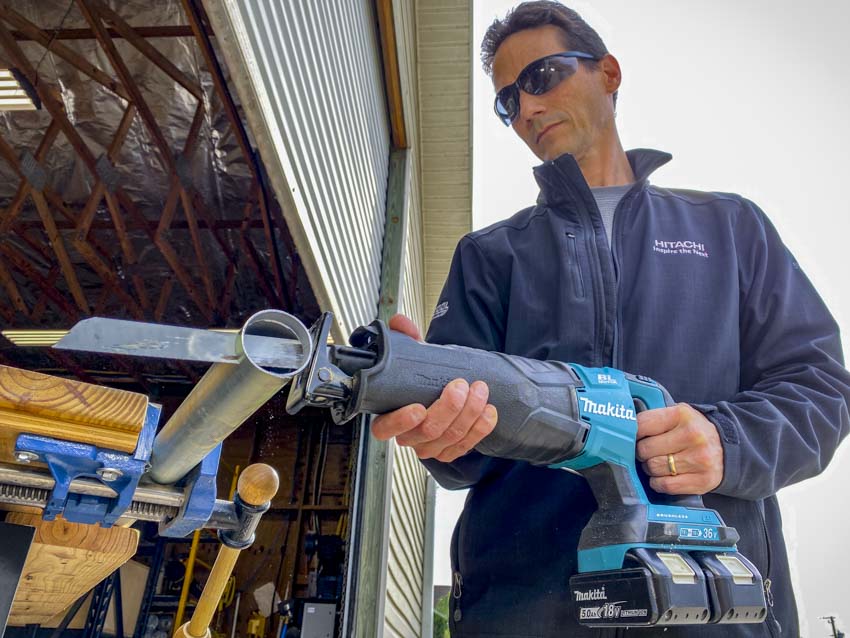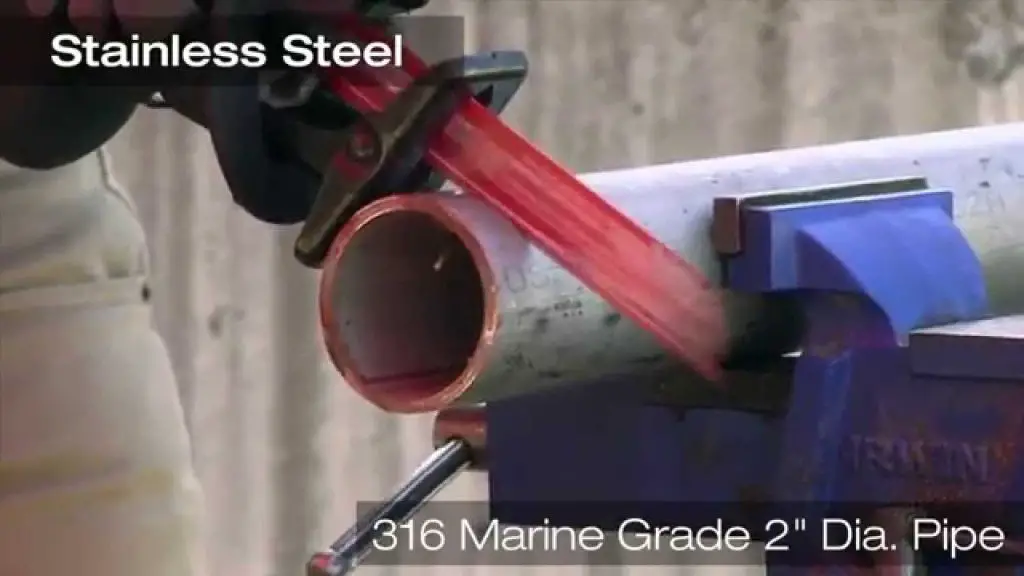Can I Cut A Pipe With A Reciprocating Saw? If you’re in a bind and need to cut a pipe, a reciprocating saw can do the job—but it’s not ideal. The blade of a recip saw is meant for cutting through wood, so it can damage the pipe and make an inaccurate cut. Plus, the vibration from the recip saw can be tough on your arms and hands.
If you have to use a recip saw to cut a pipe, be sure to put on gloves and eye protection, and go slowly to avoid damaging the pipe.
- Set the blade of the reciprocating saw to the appropriate length for the thickness of the pipe
- Place the blade against the side of the pipe, making sure that it is perpendicular to the surface
- Apply pressure to the saw and start cutting through the pipe
- Continue cutting until you have reached your desired depth
- Carefully remove any debris from around the cut area before removing the saw blade

Credit: www.protoolreviews.com
Can a Reciprocating Saw Cut Metal Pipe?
A reciprocating saw is a versatile tool that can be used for a variety of applications, including cutting metal pipe. While a reciprocating saw can cut through most materials, including metal, there are some limitations to consider when using this tool on a metal pipe. One limitation is the size of the blade.
A reciprocating saw uses a narrow blade that may not be wide enough to cut through a thick metal pipe. Another limitation is the speed of the blade. A reciprocating saw has a relatively slow blade speed, which can make it difficult to cut through thicker metals.
If you need to cut through a thick metal pipe, it is best to use a larger-sized reciprocating saw with a wider blade. You may also need to increase the speed of the blade to help make the cuts more easily.
Can You Use a Reciprocating Saw to Cut Pvc Pipe?
PVC pipe is a type of plastic piping that is used for a variety of applications. It is often used in plumbing and construction projects. PVC pipe can be cut with a variety of different tools, including a reciprocating saw.
Reciprocating saws are designed to make quick, aggressive cuts in materials like wood and metal. They can also be used to cut PVC pipe, but there are a few things you need to keep in mind to ensure a safe and successful cut. First, it’s important to use the right blade for the job.
A blade designed for cutting wood will quickly dull when used on PVC pipe. Second, the teeth on the blade should be facing downwards as you start the cut. This will help prevent the blade from binding in the material.
Finally, go slow and steadily as you cut through the PVC pipe – rushing could result in an inaccurate or dangerous cut.
Can You Cut Galvanized Pipe With a Reciprocating Saw?
Galvanized pipe is made of steel with a zinc coating. This coating protects the steel from corrosion and makes it stronger. The zinc also makes the pipe more difficult to cut with a reciprocating saw.
However, it is possible to cut the galvanized pipe with this type of saw if you take some precautions. First, make sure that the saw blade you use is designed for cutting metal. Second, put on safety goggles and a dust mask to protect yourself from flying debris.
Finally, clamp the pipe securely before beginning to cut. If you follow these steps, you should be able to safely and successfully cut the galvanized pipe with a reciprocating saw.
Can a Reciprocating Saw Cut Copper Pipe?
A reciprocating saw is a versatile tool that can be used for a variety of tasks, including cutting copper pipe. While a reciprocating saw can cut through a copper pipe, it is not the ideal tool for the job and should only be used as a last resort. The best way to cut copper pipe is with a hacksaw or a rotary cutter.
How to Use a Reciprocating Saw to Cut Metal, Wood, PVC, etc for Beginners
Cutting Metal With a Reciprocating Saw
There are a few different ways that you can cut metal with a reciprocating saw. One way is to use a metal cutting blade. These blades have teeth that are designed to cut through metal.
Another way is to use a carbide-tipped blade. These blades also have teeth that are designed to cut through metal, but they also have an extra coating of carbide on the tips of the teeth. This makes them more durable and able to cut through thicker metals.
If you’re going to be cutting through thick metals, then you’ll want to use a blade with more teeth. For thinner metals, you can get away with using a blade with fewer teeth. The speed at which you operate the saw will also affect how well it cuts through the metal.
If you’re cutting through thin sheet metal, then you won’t need to go as fast as if you were cutting through thicker plate steel.
When cutting metal with a reciprocating saw, always make sure that the blade is lubricated before beginning the cut. This will help reduce friction and heat build-up, which can damage both the saw and the material being cut.
What Can I Cut With a Reciprocating Saw
A reciprocating saw is a versatile tool that can be used for a variety of tasks. It can be used to cut through wood, metal, and plastic. This saw is also great for making quick cuts in tight spaces.
The blade on a reciprocating saw is able to move up and down very quickly, making it easy to make precise cuts.
How to Cut a Bolt With a Reciprocating Saw
If you’re like most people, you probably have a reciprocating saw laying around your house somewhere. And if you’re like most people, you probably don’t know how to properly use it. Today, we’re going to show you how to cut a bolt with a reciprocating saw.
First, gather your materials. You’ll need a reciprocating saw, a blade that is compatible with your saw, and of course, the bolt that needs to be cut. Make sure the blade you choose is the right size for the job – too small and it will take forever, too big and it could damage your saw.
Next, position the blade on the bolt. It’s important to make sure that the teeth of the blade are pointing in the right direction – away from you. If they’re pointing towards you, they could catch on to something and cause serious injury.
Now, start the saw and begin cutting through the bolt. Apply steady pressure as you move the blade back and forth across the bolt until it’s completely severed. Once it’s cut through, turn off the saw and remove the blade carefully so that you don’t accidentally cut yourself.
And there you have it! Now you know how to properly use a reciprocating saw to cut a bolt (or anything else for that matter). Just remember to always be careful when using power tools and always wear protective gear when necessary.
How to Cut Straight With a Reciprocating Saw
A reciprocating saw is one of the most versatile tools you can have in your arsenal. It can be used for a variety of applications, including cutting through pipes, metal tubing, and even concrete. However, one of the most common uses for a reciprocating saw is simply making straight cuts in wood.
While it may seem like a daunting task, cutting straight with a reciprocating saw is actually quite easy – as long as you have the right technique. Here’s how to do it: Start by clamping your workpiece down to a stable surface.
This will help ensure that your cuts are nice and straight. Next, position the blade of the saw so that it’s perpendicular to the workpiece. Then, simply start the saw and slowly guide it along the length of the workpiece.
Be sure to keep your hands steady and use gentle pressure – there’s no need to force the blade through the material. If you find that your cuts are veering off course, simply stop and reposition the blade before continuing. With a little practice, you’ll be able to make perfectly straight cuts using a reciprocating saw!
Conclusion
If you need to cut a pipe and don’t have the proper tools, a reciprocating saw can do the job in a pinch. Just be sure to use the correct blade and take safety precautions.

I’m John Carry, also known as a woodworker I have been a professional saw expert for over 10 years. I’d work with every type of saw machine out there, and experiment to find which tools work better.
I’m always looking for ways to improve my skills and help those around me. I love my job and am always happy to share my knowledge with others.


